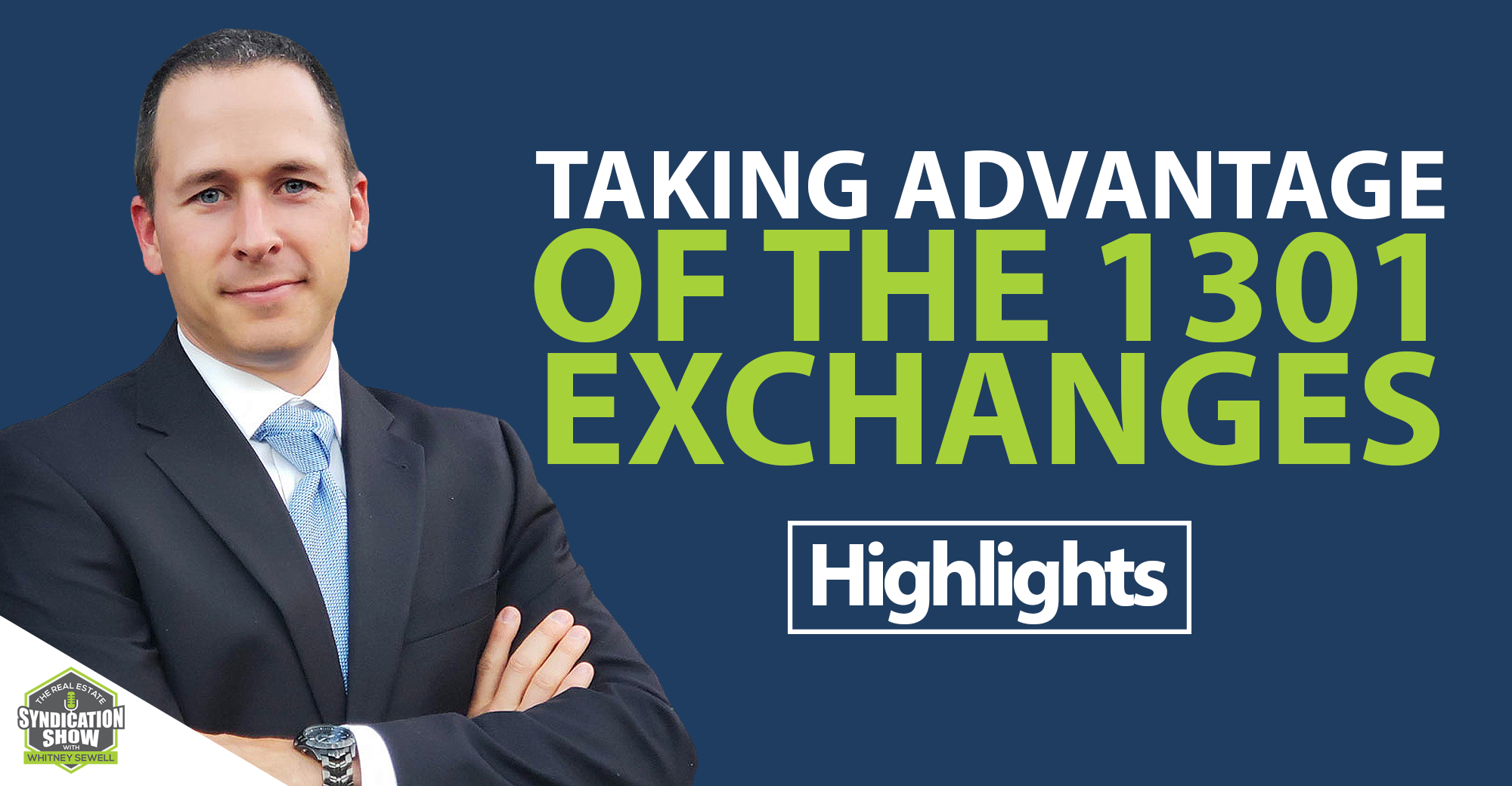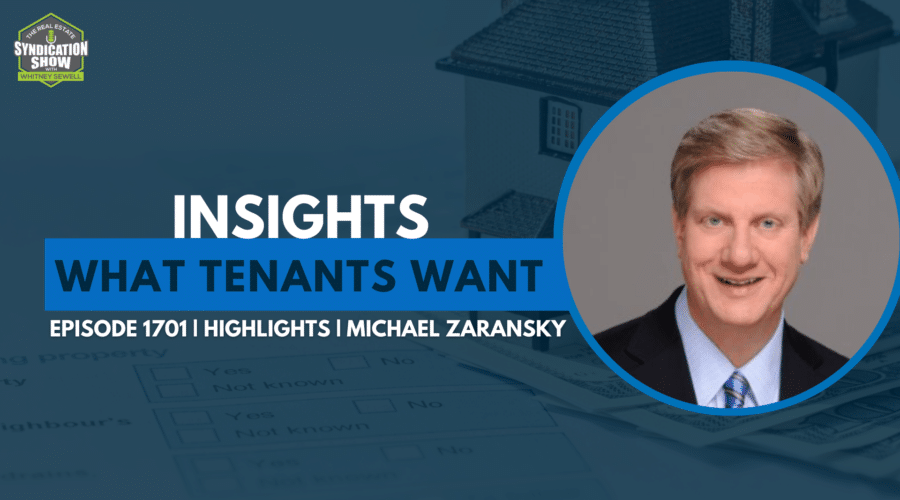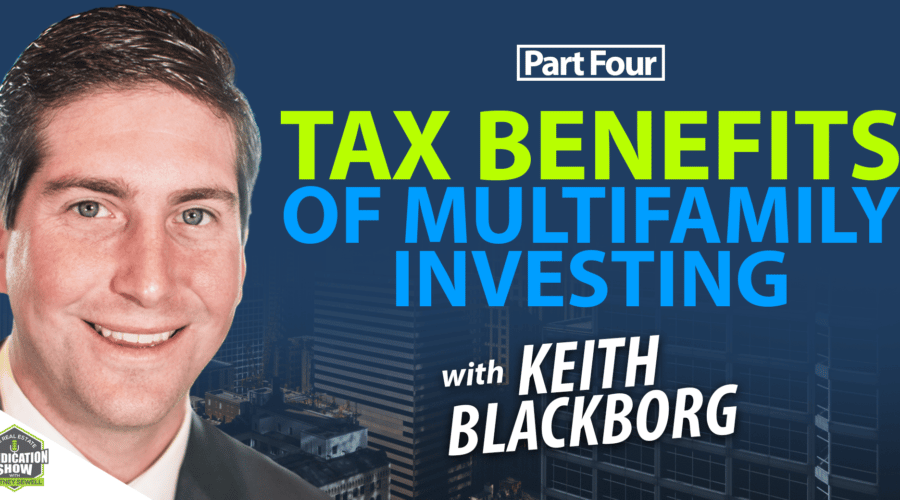It is possible to do a 1031 exchange into syndication. In this #Highlights episode, we look back at our conversations with Ted Lanzano, Alex Shandrovsky, and Michael Brady. They talk about how you can take advantage of 1031 Exchanges and enter into syndication.
Watch the episode here:
Listen to the podcast here:
Ted talks about 1031 exchanges and how they can be used smartly for increasing your net worth. He also gives a bunch of examples of how you can use this strategy in your real estate business and keep growing your assets, all the while avoiding large taxation. Meanwhile, Alex and Michael shed light on some of the more technical aspects, such as complications that come with doing a 1031 exchange into syndication, the role of the 1031 investor in the syndication, and how to structure a deal with this type of investor. Click the play button and learn more about how you can take advantage of your 1031 exchanges!
Key Points From This Episode:
- Deferring capital gain on a sale and increasing net worth through a 1031 exchange.
- The role of market timing in this exchange strategy.
- Basic concepts to understand when considering a 1031 exchange.
- Leveraging these timeframes in smart ways and giving yourself some extra runway.
- Cost segregating properties and how this fits into the 1031 model.
- When is too late to pursue a 1031 exchange during the sales process?
- What is a reverse 1031 exchange? Purchasing before a sale!
- Alex and Mike’s backgrounds and why they are an ‘odd couple.’
- An explanation of a 1031 and what would motivate an investor to do this kind of exchange.
- Two sets of challenges come with bringing a 1031 investor into syndication.
- The root cause of why 1031 exchanges into syndication can be so complicated.
- Two ways that the same investor can be on both sides of a 1031 exchange.
Tweet This!
“I mean, it (1031) really is one of the available strategies when you sell an investment property. It’s one of the available strategies to defer the capital gains on the sale of a property. It’s probably in my mind, the most important wealth-building strategy in real estate investing.” – Ted Lanzano
“It’s a great strategy when you’re picking up things at the bottom and then selling them as the market rises.” – Ted Lanzano
“1031 exchange is a term-free, interest-free loan from various levels of government. We’re talking about the federal government as well as the various states and some cities that actually impose taxes on capital gains, that allow you to go out and buy bigger, hopefully, more profitable properties.” – Michael Brady
“There are two different challenges that are kind of two sides of the same problem. It all stems from the fact that essentially, the taxpayer who sells the relinquished property, that’s the property that they’re going to defer the taxes on, has to be the same investor that buys the replacement property which is the property they’ll be investing their capital gain in.” – Michael Brady
Links Mentioned in Today’s Episode:
WS313: The Benefits of a 1031 Exchanges with Ted Lanzaro
WS466: Navigating a 1031 Exchange into a Syndication with Alex Shandrovsky & Michael Brady
About Ted Lanzaro
Ted Lanzaro is a Certified Public Accountant and real estate investor with over 29 years of real estate consulting and investing experience. He is also the author of The Tax-Smart Landlord, a book of tax strategies for real estate investors. Ted has helped thousands of investors nationally save millions of dollars in taxes in his career.
About Alex Shandrovsky
Alex Shandrovsky is a Silicon Valley seasoned entrepreneur. Starting with a $3,000 Loan, He built a multi-million dollar catering business serving leading tech companies including Google, Airbnb, and Facebook. . He has been featured in numerous publications including Haaretz, Newsweek, and San Francisco Chronicle and has studied Digital Marketing at Dartmouth University Business School. As a Senior Business Development representative for Madison 1031 Exchange, Alex has the privilege of building multigenerational wealth for driven real estate investors. He is a proud husband and father to 3 adorable children
About Michael Brady
Michael S. Brady is Executive Vice President of Madison 1031, a national Qualified Intermediary for tax-deferred Exchanges pursuant to Internal Revenue Code §1031. As a Certified Exchange Specialist® and attorney, his responsibilities include consulting with clients and their advisors to provide guidance on the regulations affecting §1031 Exchanges, as well as overseeing Madison 1031 Exchange’s national sales and marketing efforts. His seminars have received rave reviews for being both entertaining and informative, and his audiences have included top law and accounting firms as well as brokerage companies nationwide. Mr. Brady has published many articles on tax and legal issues and is the primary author behind the Madison 1031 Zone blog. Prior to joining Madison 1031, Mr. Brady headed up three other leading 1031 exchange companies, overseeing several thousand 1031 exchange transactions during his career. As an attorney, Mr. Brady has over 25 years of experience representing clients in commercial and residential real estate transactions, as well as a wide variety of business transactions and commercial litigation matters, and has acted as general counsel to a title insurance company.
Full Transcript
EPISODE 1301
[INTRODUCTION]
0:00:00.0
Whitney Sewell (WS): This is your Daily Real Estate Syndication Show and I’m your host, Whitney Sewell. Today is a Highlights show that’s packed with value from different guests around a specific topic.
Don’t forget to like and subscribe but also go to LifeBridgeCapital.com where you can sign up to start investing in real estate today. I hope you enjoy the show!
[INTERVIEW 1]
WS: Our guest is Ted Lanzaro. Thanks for being on the show, Ted.
Ted Lanzaro (TL): Thank you, Whitney, for having me. I really appreciate it.
WS: I know a lot of investors that are listening are wondering, how do we do this? What does that mean? Is this something I should do, this 1031 lingo that we hear all the time, right? Let’s get started as far as, maybe you give us just some brief background on what this is, and then let’s dive into some details.
TL: Okay. Yeah. Sounds good. I mean, it really is one of the available strategies when you sell an investment property. It’s one of the available strategies to defer the capital gains on the sale of a property. It’s probably in my mind, the most important wealth-building strategy in real estate investing. Here’s why, let me give you an example. I had a client who was a plumber, okay? As a plumber, he would go out and he would do his business, but he also started picking up small residential units, a two-family here, or four-family there, a small apartment building.
Over a period of about eight years, he built up a portfolio of about 150 units, right? That he was running and managing locally. Now, this was in South Florida and this was at a time when the market was beginning to rise. Prices were starting to go up. What he did was he actually sold his entire portfolio to another investor. He would have had about a million-dollar capital gain on the sale of all of those properties.
What he did was he decided, “Well, I’m going to do a 1031 Exchange.” He went and bought a shopping center on the main road in Boca Raton, Florida where I lived, and used that shopping center as his replacement property. He never paid tax on the million dollars. He just did this 1031 Exchange and bought a replacement property for actually more than what he sold the whole portfolio for.
Now over the next year, year and a half, he’s fixing up the shopping center and he’s putting new tenants into it, right? The markets continue to rise at this point also. At one point when it’s complete, he’s got it fully rented. He gets an offer for it, which is 2 million dollars more than he paid for, okay? Now he’s got basically a 3 million dollar capital gain. He’s like, “Well, what do I do now? I’m going to do another 1031 Exchange.”
He took the proceeds from the shopping center and he ended up investing them passively into six AutoZone buildings in Texas, which cost him a little bit more than what he had sold his shopping center for, but now he’s completely passive. It’s a triple net lease, so AutoZone is paying all the expenses on the buildings. He has a management company that basically collects the rent, writes the mortgage check, and sends them the balance. At that point, he’s making about $40,000 a month. Totally passive and now he’s retired, right?
He’s never paid the – he’s up now like 3 million dollars in capital gains and hasn’t been a set in capital gains taxes, because he’s been using the 1031 Exchange to defer these capital gains. You can see how that’s over the course of about five years, his net worth went up by 3 or 4 million dollars, but he never paid a dime in taxes. That’s why I say it’s a very important wealth-building strategy.
WS: Wow. I was going to ask you about how long that took, but you said about five years. That’s –
TL: About five years.
WS: – very impressive. Do you think that was the timing of the market when he got in? Or do you think that most people could do that in say, four to six years?
TL: Well, I think a lot of it had to do with the timing of the market, right? It’s a great strategy when you’re picking up things at the bottom and then selling them as the market rises, okay. Now, did he pay a premium for the property he bought in Texas at the end of the AutoZones? Yeah, because he was at the height of the market at that point, but it was also deferring gain and he knew he was getting into a low-return scenario, but he had already deferred all of this gain. It was triple that. It was easy. It was passive. He didn’t have to do anything else, but collect his money every month.
WS: Wow. Five years of retirement right there. That’s awesome. What are some, I guess, some basic rules, some basic things we need to understand if we’re looking at this same scenario, or being able to do 1031 from one deal to the next and grow our portfolio that way?
TL: Okay. The way it works is that when you sell a property, all of the proceeds of that property go into escrow, or what’s called a qualified intermediary. It’s somebody who facilitates 1031 Exchanges. At that point, you have 45 days to identify properties. You can either identify up to three properties of any market value, or you can identify more than three properties, but they can’t be more than double what the value of the property you’re selling is.
At that point, after you’ve done your identification, you then have a total of 180 days to close on one or more of those properties. From a practical and investor standpoint, right, you don’t start looking for the properties the day of the closing of the property you’re selling. I mean, you know you’re selling a property. There’s typically about from the time you sold the contract from the time the buyer gets through their due diligence, right? There might be three months’ notice.
You should be looking at a property that whole time, right? So that you’re actually adding to the clock by looking for replacement properties before the 45-day window ever even starts, which is the day you close on a sale. What could people be doing now, where the market is a little tighter, or whatever, right? Let’s say, I have a property that I might be willing to exchange, or let’s say I come across a great property right now, right? I know that I can put my other property on the market and probably sell pretty fast in this market. There’s a huge demand for rental properties right now.
Let’s say, I find a property that I know has a better rate of return than something I currently own, right? Well, now I can actually just say, “Okay, look. I’m going to buy this property.” I even start that process and then I put my other property on the market with the idea that I could probably – they might even end up exchanging simultaneously, right?
WS: You begin the process of buying the second property before selling the first one?
TL: I could if I wanted to, right? Because I’ve identified this property. Maybe I just put a contract on it, knowing that I could sell. I mean, this is from an investor standpoint, right? Knowing that I can sell my existing property. Correspondingly, right? If I’ve got a property that I’m making, that I bought 10 years ago and I’m making 10% on it, I need to be able to find a better property in this market. That’s why a lot of 1031 Exchanges, at least right now don’t happen, because it’s very difficult to find a better replacement property.
I have a client who sold the property. He’s got a million-dollar capital gain in it, to the cost $300,000 if he has to pay the taxes. Well, we ultimately came – after looking at what was available in this market where he wanted to be, we ultimately came to the conclusion that he was better off paying the taxes than he was buying a property that he wasn’t going to get a really good rate of return on and was going to be a management problem for him because he didn’t want to have big management problems.
WS: Wow. He didn’t want management problems. What did end up happening with him, or can you elaborate?
TL: Well, in this scenario he ended up paying the tax, which is one of the – it’s not the best strategy, right? Right now, there are only four real things you can do. It pays the tax, 1031 Exchange, seller financing, and an installment sale. Now you’ve got the new opportunities, own scenario also that you can defer stuff. With the 1031 Exchange, you’re getting – it’s not in with the opportunity zone, you’re giving a short-term deferral with the 1031 Exchange. You can actually get a much longer-term deferral possibly forever because getting back to my client that’s got the AutoZones in Texas, his ultimate plan is to pass those properties on to his kids, right?
When he dies, his children will get a step-up in basis on those properties, that’s the existing tax law. What will happen is they’ll inherit the property at whatever the market value of that property is at that time. If they were to turn around and sell those properties the next day, literally, right?
They would have zero capital gain on the property because whatever the market value is, that’s their basis, right? That’s another very powerful strategy. If you think about it as using 1031 Exchanges to ladder up to your portfolio and then passing them along to your children. The increased, nobody ever pays a dime in capital gains on the increase in the market value with those properties.
[INTERVIEW 2]
WS: Our guests are Alex Shandrovsky and Michael Brady. Thank you both for being on the show today, guys.
Alex Shandrovsky (AS): Pleasure.
Michael Brady (MB): Yeah, thanks for having us.
WS: All the listeners, if you are in the syndication business, this is a topic and question that I get often and that I’ve had to deal personally in our own business as well is how do we do a 1031 exchange into a syndication? You know, it seems so complex in the beginning and what that should look like and I know you as the listener also have questions about how to do this properly. And these guys are experts. They are the experts on 1031 exchange. But a little about them, before we get started.
They both represent Madison 1031, a national qualified intermediary for tax differed exchanges, internal revenue code 1031. Alex is a Silicon Valley seasoned entrepreneur, starting with a $3,000 loan, he built a multimillion-dollar catering business serving, leading tech companies including Google, Airbnb, and Facebook.
As business director, for Madison 1031, he provides clients with expert lawyer and CPA approved 1031 exchanges. Michael is executive vice president at Madison 1031 and is a certified Exchange Specialist and attorney. He has over 25 years of experience representing clients in commercial and residential real estate transactions as well as a wide variety of business transactions and commercial litigation matters and has acted as general counsel to the title insurance company.
Guys, thank you all again for your time today. But get us started a little bit about maybe just briefly, you know, two of you at one time, we don’t have tons of time to dive in the backgrounds but just briefly tell us a little bit about yourself so we can get into this subject that I know a lot of people are wondering about.
AS: Yes, Mike and I are kind of like the odd couple a little bit. My background is a small business operator. So essentially, I started a small business in Silicon Valley and one of the things I was always looking for is how to be able to scale my cash flow, right? I learned much more about real estate and real estate services, which brought me to Madison 1031 but I look at from, the small business operator as looking in and be able to create the most effective investment possible. Mike, share a little about yourself.
MB: Yeah. Sure, I’m an attorney as you heard, predominantly in business and real estate, got involved in 1031 exchanges in 2005 specifically or exclusively as a qualified intermediary. And during that time, I’ve helped investors defer I’d say probably about a billion-dollars in taxes and doing tax deferred exchanges and structuring transactions. Specifically, with syndicators and some ideas we have for syndication.
WS: Awesome, I mean, that’s a big deal to defer, you say a billion dollars?
AS: Yeah.
WS: A billion dollars in taxes. I mean, what a great vehicle or avenue here that we need to know about, you’re in real estate business, you need to know about a 1031 exchange and specifically in syndication business. Need to know how to help that investor who has that property they’re selling and they’re selling and they want to invest.
Like I want to be confident in this to be able to say, “Yes, you know, we can do this or no we can’t.” Or, if we do it, this is how we need to move forward and so, you know, if you all could just you know, elaborate or get us started in this process, I’d love to be able to speak to the operator that’s listening right now that’s saying you know, I don’t know if I can take 1031 money into my syndication. You know, maybe you know, you all can get us started in that and let us walk through that process.
AS: Mike, is it all right if I just start of for a second?
MB: Yeah, absolutely, go ahead, Alex.
AS: Let’s just take a second first to think about the motivation of 1031. Maybe that’s just actually doing a 1031 exchange. What’s the mindset that 1031 investors? Then we’ll bring it into this syndicator.
Essentially, an example I’ll have to use is the IRS is kind of like the uncle Sam, he’s always that strange uncle who invest with you at every single investment you make. And when you’re ready to actually sell the investment, and has been appreciation, he’s coming to you and saying, “Look, we did so well, it’s time for you to give me a percentage of that appreciation.”
Now, he says, “Wait a second, you done so well in the market that I really want you to stay, keep your money in the market. What I’m going to do is give you this 1031 exchange vehicle which is going to allow you to fully reinvest all the proceeds from the sale, into another – into a like-kind exchange and another like-kind investment property.”
Now, there’s a lot of stipulations and limitations around that but the motivator behind the individual but doing a 1031 exchange is. First of all, he’s an individual who is looking to reinvest all the proceeds of his sale into the market. He’s not looking to just cash out.
Two is usually those individuals are looking for long term play, right? Some of the individuals that we interact with are going to continue doing exchanges until the point of death, right? Where it’s going to allow that the basis for the inheritor. We’re looking for somebody who is a long term thinking and seasoned investor and really is ready to be able to play long-term in the market and the government is working with alongside of him to move the market forward.
Now, Mike, could you share a little bit, some of the challenges of a syndicator, when he is looking at bringing a 1031 investor inside of his syndicates?
MB: Yeah, absolutely. Just kind of support what you just said, you know? These are essentially – 1031 exchange is a term-free, interest-free loan from various levels of government. We’re talking about the federal government as well as the various states and some cities that actually impose taxes on capital gains, that allow you to go out and buy bigger, hopefully, more profitable properties.
With syndicates in particular, there’s some challenges. The way I look at it is two ways: you have syndicators who are looking for 1031 investors, okay? That’s one set of challenges, bringing 1031 money into a syndication as well as the flip side that when the syndicated deal is ready to be turned over, going to be sold to a third party, how do we get our syndicated investors out and allow them to do 1031 exchanges?
There are two different challenges that are kind of two sides of the same problem. It all stems from the fact that essentially, the taxpayer who sells the relinquished property, that’s the property that they’re going to defer the taxes on, has to be the same investor that buys the replacement property which is the property they’ll be investing their capital gain in.
Then we’re talk about tax payers and so what happens with syndicated deals is predominantly, they are set up these days in limited liability companies. They could be limited partnership as well that typically are going to be viewed as a partnership for tax purposes, okay? That means the partnership is actually going to be the entity or the tax payer that owns the property. We can certainly have a tax, you know, an LLC or a limited partnership sell a piece of property and go buy a piece or replacement property in that same structure and that’s fine, we can do that all day long, it’s the same tax payer on both sides of the coin.
It becomes more problematic that what we have individual who is selling a property and wants to invest in a syndicated deal that’s owned by a partnership and vice versa if we have a syndicated deal and a partnership that is going to now sell and we have individuals who want to go off and buy in their separate in their own names or you know, different entities. That’s the problem and that’s really the crux where the issue. It’s a very complicated issue, it’s a tough one to get around.
Essentially, what we have to do is we have to allow for the same investor of both sides of the exchange. This can be done two ways. Typically, with the investment into a syndication with a 1031 investor who would have the investor join in the property, not as a member of the ownership entity, the limited liability company of the partnership, we would bring them in as a tenant in common. They would have a separate deeded interest in the project, along with the syndicated entity, okay?
There’s some formalities we have to respect in that relationship, you know, this is not a great arrangement for syndicator where you would have some preferred returns, some waterfalls and you know some funds for syndicator but initially, we want to bring them in as a tenant in common and you could have these co-owners, we should look at – I’m going to throw out some legal lingo here so forgive me, we want to look at Revenue Procedure 2002-22 which gives us some guidance, I’d have to set up at a tenant in common versus a partnership. You know, they can operate that way for a period of time and at some point down the road and they’re not necessarily a magic number, they can then have the 10 income investor, contribute their ownership to the syndicated and become part of the family essentially. Okay, that’s one way for bringing in in syndicated money.
Likewise on the exit from the syndicate, we also have to kind of bring ourselves out of the partnership model into individual ownership so we would do something – typically it’s called a drop and swap where we would basically have the syndicate deed out individual interest in the property to the tax payers to the syndicated – the investors.
So that they can then go on their separate ways and go buy replacement property on their own. There are some timing consequences to that, we want to do this in advance, we don’t want to do this at the last minute. It may make sense, you know, a couple of years before the target of going the property to restructure the entity, independent in common, that’s some things to look at, this is something that you really need to work with tax and legal advisors in advance and planned to make sure that you’re going to be in compliance or have your transaction meet scrutiny at the IRS or the state governance were to audit.
WS: No doubt about it. I mean, you just proved that okay, we need expert counsel because most of that just went over my head.
MB: Yip. I’m sorry about that.
[END OF INTERVIEW]
[OUTRO]
0:18:02
Whitney Sewell: Thank you for being a loyal listener of The Real Estate Syndication Show. Please subscribe and like the show. Share with your friends so we can help them as well. Don’t forget to go to LifeBridgeCapital.com where you can sign up and start investing in real estate today. Have a blessed day!
[END]
Love the show? Subscribe, rate, review, and share!
Join the Real Estate Syndication Show Community:








